The Gundestrup Cauldron - Mythology
and Cosmology
The Native Way of
understanding Cosmos
Gundestrup Cauldron Peat bog, Gundestrup
(Denmark) First century B.C.E. Silver partially gilded. Diameter
69cm., Height 42cm.Copenhagen, Nationalmuseet.
The Gundestrup Cauldron is a religious vessel
found in Himmerland, Denmark, 1891. It was deposited in a dry section of
a peat bog, dismantled with its five long rectangular plates, seven
short ones and one round plate. Each plate is made of 97.0% pure silver
and filled with various motifs of animals, plants and pagan deities.
Sophius Müller(1892) reconstructed these plates into the present form of
the cauldron: five rectangular plates are placed in the inside of the
cauldron leaving 2cm of space between each, and the seven (originally
eight) plates form the outside of the cauldron. The round plate is
assumed as the base of the cauldron. The reconstructed cauldron with its
spherical base and cylindrical side is 69cm. in diameter and 42cm. high;
both the inner and outer plates are almost of the same height ( about
21cm) forming the cylindrical side of the cauldron.
As the largest surviving piece
of Europian Iron Age silver work, the Gundestrup Cauldron has been given a
special interest by many scholars. Especially, its high quality
workmanship and iconographic variety have generated an incessant inquiry
into the origin of the cauldron. Though the date of the cauldron is
generally attributed to the 2nd or 1st century BCE
(La Tène III), there still remains much room for controversy concerning
the place of its manufacture. The main problem comes from the fact that
its style and workmanship is Thracian rather than Celtic despite its
decorative motifs manifestly Celtic. So far, scholastic opinions have been
largely divided into two groups: those who argue for the Gaulish origin
and those who argue for the Thracian origin. The former locate the
manufacture of the cauldron in the Celtic west while the latter opt for
the Lower Danube in southeastern Europe.
The Vessel
The whole vessel represents the Whole World
as known from the ancient 3 World division and dimension of Earth, the
nearest Celestial World and the farthest celestial world of the Milky
Way.
- Maybe the Vessel also once have had a lid
in order to show some details regarding "the top" of these 3 Worlds? In
that case the imagery would have shown some mythological "world axis"
imagery.
Interpretation
In Norse Mythology these 3 worlds is
mentioned: Midgaard for the humans; Asgaard for the nearest celestial
world where the Sun, the Moon, the (5) Planets and for the Star
Constellations and Udgaard (Out-Yard) for the farthest world
representing the Milky Way galaxy where the Giants (Jaetter) live.
The interactive Mytho-Cosmological plays
between these 3 worlds must be incorporated in the telling of vessel
imagery. That is: We are dealing with the cosmological creative and
interactive forces in these 3 worlds and we are also dealing with the
Mytho-Cosmological geographical and celestial locations of these 3
worlds.
- Some knowledge would be of an obvious
physical character as for instants day and night observations and the
Seasons, and even the immediate knowledge of the "Udgaard",
the Giant Milky
Way contours. But the fully knowledge beyond the Milky Way, could only have been
collected by spiritual means i.e. by Shaman travelling gathering
intuitive, non verbal knowledge. It is the intuitive travelling
knowledge "beyond" the Milky Way, that is incorporated in the Worlds
Creation Myths.
The Plates
- The Base: A Bull in the center. A Woman
with a Sword, Bull and 2 Dogs
- 5 inner plates.
- 7 outer.
- The plates on the outside show
4
male and 3 female busts.
- (Maybe there once also was a Lid?)
The Base

In the Norse Mythology Creation Story,
http://www.native-science.net/Creation.Myth.Norse.htm the Giant
Audhumbla Cow/Bull, located in the southwards warmer and lighter
Muspelheim, "licked forward" the Milky Way Giant of Ymir,
the northern hemisphere Milky Way figure.
The logical choice of a Bull/Cow comes from
combining the Bull's roar with the thundering sound of creation in the
Milky Way galaxy center. And of course when also choosing a Cow and the
Utter milky symbols, this gives the natural associations to nourishing
and to the white river of the Milky Way and thereby building op the the
telling of how all life once began in the center of our galaxy.
On this base plate, the Bull/Cow is centered
southwards as in the Milky Way center in the Star Constellation of
Sagittarius, and Ymir is hovering above as the northern Milky Way
contours on the Northern Earth night hemisphere. (A physical observable
symbol)
http://www.native-science.net/MilkyWay.GreatestGod.htm
Inner Plate A
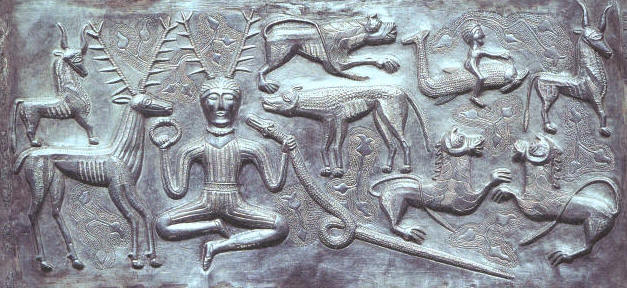
This plate shows a variety of animals
around the horned figure in the center. The horned figure is presented
with his legs folded and wears a torque around his neck. he holds
another torque in his right hand and a horned serpent in his left hand.
This torque-wearing god with stag antlers is generally identified as the
Celtic god, Cernunnos. Cernunnnos is the Lord of the animals and the
torques he wears are the symbols of wealth and prosperity. Cernunnos was
first recognized by the inscription of the Paris
monument which, along with the inscription, shows a horned deity
wearing torques on his antlers. Because of this antlered deity, this
plate has often been cited by those who argue for the Gaulish origin.
However, this general identification of the central figure with
Cernunnos has been challenged by some scholars. As early as 1971, Powell
noted that there is no ground for believing that every Celtic horned god
should be called "Cernunnos depending solely upon the defective
inscription in Paris. In agreement with Powell, Olmsted(1979) suggests
that the figure be classified as "Dieu Accroupi." According to him, all
of the "accroupi" figures with antlers, torques and serpent come from
north central Gaul, while only a quarter of the "accroupi" figures with
one or two attributes come from outside the region.
Apart from the identity of the horned
deity, it is recognized, however, that the posture and dress of the
figure are not necessarily Celtic. His folded legs seen from above hint
at the possible link with Buddhism in the East and his costume -
tight-fitting breeches and coat fastened by a belt at the waist - is
often matched by the costumes of horse-riding races from southeastern
Europe. More recently, Anders Bergquist found that the shoes of the
deity with zig-zag bindings are exactly the same type as those found in
Thracian silver repoussé from Sãlistea and
Durentsi.
His discovery seems to confirm the eastern influence on the Gundestrup Cauldron for no such examples have been found in the Celtic West.
Although, as in the identification of the
central figure, scholars have difficulties in identifying some animals
surrounding the central figure, it is generally accepted that beside him
on the left and right are a hound and a stag. On the back of the stag is
depicted a bull which repeats itself on the upper left corner of the
plate. The bull on the left is followed by two other animals: a dolphin
with a rider and a lion. However, the identities of these animals have
been occasionally refuted. For example, Powell argues that the dolphin
is actually a sturgeon. Also, the lion right behind the dophin is
identified as a boar by some scholars. Finally, a confronted pair of
animals in the lower left part of the plate are generally considered as
lions. These diverse animals are given special interest by those who
argue for the Thracian manufacture of the cauldron. Powell claims that
the stag and bulls have the "stolid look" that seems to have come from
eastern Europe and that the confronted pair of lions are typically
oriental.
Concerning the iconography of the plate,
many scholars assume that the plate has a coherent narrative. Klindt
Jensen notes that the eyes of the three figures- Cernunnos, the stag,
and the hound- are level, thus suggesting a striking connection between
them. Most notably, Olmsted identifies the central figure as a Gaulish
prototype of later Irish Cú Chulainn in Táin and reads the whole
plate as a combination of episodes from the same tale. According to him,
the sequence of the three figures on the upper left corner describes the
various transformations (shape-shifting) of the two Irish bulls: Donn
Cuailnge and Finnbennach. He calls attention to the fact that the
sequence of animal transformations ending in the two bulls occurs in the
same order in both the tale and the plate.
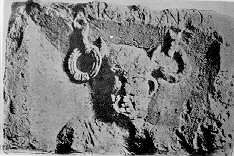
(Paris Cernunnos)
Interpretation:
When one observe a man riding on a Dolphin,
one cannot possibly think of a scene of Earth. This stage is not set and
played out in the human Norse Midgaard area. The dear-horned younger man hold
the Torque symbol of Life in his right hand, and also around his neck,
and the Serpent symbol of creation in his left.
Inner Plate B
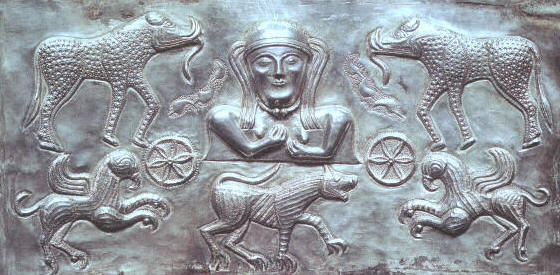
This plate shows an antithetical
arrangement of animals around a bust of a goddess. The goddess is
presented in the center with a six-spoked rosette wheel on either side
of her. She is flanked by two elephants confronting each other. Below
them are two griffins arranged in the same antithetical manner and a
hound is placed in the lower center of the plate, between these two
griffins. The goddess seems almost identical with the goddess on
plate
(g): she has S-curve hair strands and curvilinear eye-ridges forming
a T-shape with her nose. The rendering of her arms is also similar to
that on
plate (e). Though it is not certain that the six-pointed wheels
represent a wagon, the goddess is usually interpreted as riding a wagon.
Actually, a chariot is often represented by a single wheel of the same
type in Gaulish coinage. Olmsted suggests that the presence of the
elephants on either side of the wagon could have resulted from the
influences of the Roman coinage which portrays elephants pulling a
chariot. Olmsted also identifies her with the Celtic Goddess Medb. She
is a god of war and rulership; diverse animals and the chariot represent
her war-like nature as a territory goddess.
Though elephants are also depicted in the
Celtic west, the fantastic characters of the animals are often explained
in the oriental context. Especially the griffins with their segmented
wings and rounded bird heads are similar in concept to those imaginary
animals often observed in
Thracian
metal works (Phalerae). Even the elephants suggest an oriental
influence. Olmsted notes that the elephant is less a manifestation of
the actual animal than a synthetic creature incorporating diverse parts
of other animals: the body of the elephant shows the rear leg and tail
of the bull on the
plate
(D) and the trunk of the lion on the
plate
(C). Its head is also same as that of the bull except its trunk,
clumsily added to the head. Thracian characters of the animals are more
clear in their hanging feet: the feet of the griffins are literally
hanging in midair, not wearing any weight of the body. The bodies of
these animals are decorated with interspersed large and small dots and
lines. This also can be read in the context of Thracian workmanship for
the decorative techniques of hatching and punch marks are characteristic
of Thracian silver smithing.
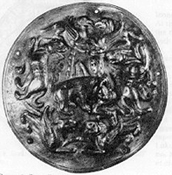 (Phalera from
Stara Zagora) (Phalera from
Stara Zagora)
Inner Plate C
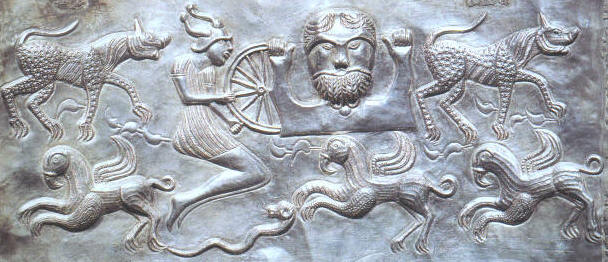
This plate shows an intriguing iconography
of two deities with a broken wheel: in the center of the plate, a bust
of a bearded deity is depicted with a half-shaped wheel on his right
side and a full-length leaping figure is holding the rim of the wheel
from the right. Under this leaping figure, a horned serpent is
presented. The rest of animals are placed clockwise around this group of
two deities: in the upper part of the plate, two identical beasts are
depicted on either side of the group, both facing the left side of the
deities and in the lower part, three griffins are depicted in parallel,
all facing the right side of the deities. The space between the upper
and lower group of the animals is filled with some botanical patterns
which are usually identified as ivy tendrils.
The bust of a bearded god in the center is
almost identical with the small bust on the right shoulder of the
goddess on
plate
(e). On the other hand, the leaping figure holding the wheel on the
left is similar to the gods of the
plate
(A) and
(E)
in its size and dress. He wears tight fitting, short-sleeve clothes and
a horned helmet ending in knob like terminals. Drawn on these
similarities, Olmsted reconstructs the narrative of this plate in
relation to the other plates; according to him, the gods on plates (A),
(C), (E) are different representations of the same god, the Gaulish
version of Cú Chulainn in Irish tale Táin Bó Cuailnge. Like Cú Chulainn
in the Táin, the young god wearing the horned helmet uses a broken wheel
in confrontation with the bearded god, Fergus who, on plate (e),
accompanies the goddess sharing traits with Irish Medb. The horned
serpent under the feet of the young god can be read as the Irish goddess
Morrigan who, in another anecdote from the tale, disguised herself in
the shape of an eel and finally had her ribs crushed under the feet of
Cú Chulainn.
Indeed, the unique presence of a broken
wheel suggests that this plate may be a description of a particular
narrative. Yet, there is no guarantee that this half shaped wheel was
meant to be a broken wheel. Ellis Davidson notes that the wheel was a
familiar Scandinavian symbol in the period of the late Bronze Age, a
basic motif in the rock carvings which continued to appear throughout
the Iron Age. On the other hand, some scholars identify the bearded
deity with Jupiter Taranis of the Celts whose traits are wheels.
Besides, Olmsted fails to explain the existence of the fantastic animals
such as lions(?) and griffins. Even if we accept his argument that the
beasts in the upper part of the plate are variants of the wolf, the
griffins are completely inexplicable in the context of the Irish tale,
Táin, for griffins are unknown in early Irish tradition. Actually, these
griffins are all the same with their segmented wings, rounded bird heads
and hanging feet as those on
plate
(B). As manifest examples of Thracian style, they are often compared
with the fantastic animals of Sark, Helden, Paris phalerae of Thracian
origin and the Agighiol vase (belonging to 4th BC Thracian
style). Especially the
Agighiol
vase shows the parallel expressions of the hanging feet depicted on
plate (B) and (C): the deer with their legs dangling in midair as well
as griffins and lions.
 (Agighiol Vase)
(Agighiol Vase)
Inner Plate D
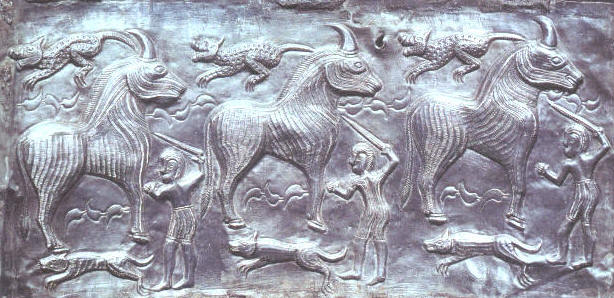
This plate is generally interpreted as a
bull-slaying scene. Three bulls are placed in a horizontal line, facing
the same direction. They have massive, ham-like rumps and short but
thick necks which resemble those of a bull on the
Sark
phalerae. Focusing on their shape and hatching patterns of the
bodies, Powell traces their origin back to Anatolian and earlier
Urartian tradition. On the lower right side of each bull, a man is
standing in the posture of attacking the bull with a sword. Under the
feet of each bull, by the side of each man, a dog is depicted as running
toward the left while a cat-like creature is running in the same
direction over the back of the bull. These cats as well as the dogs have
the same hanging feet. As shown in other plates, the spaces between each
figure are filled with tear-drop shaped leaves.
The three fold composition of this plate is
often related with the Celtic triad in which the actions of heroes and
the slaying of monsters are set in groups of three. Here, the figures
are not completely identical; the middle man wears a jacket and the
other two do not. However, the basic concept of the composition seems to
have a strong connection with the Celtic tradition. Since all the bulls
and human figures are represented in a highly stylized, static,
monumental posture, Ellis Davidson concludes that the scene depicts a
ritual killing with "no attempt at realism."
Inner Plate E

Interpretation:
This plate is horizontally divided
in the middle by the Tree of Life.
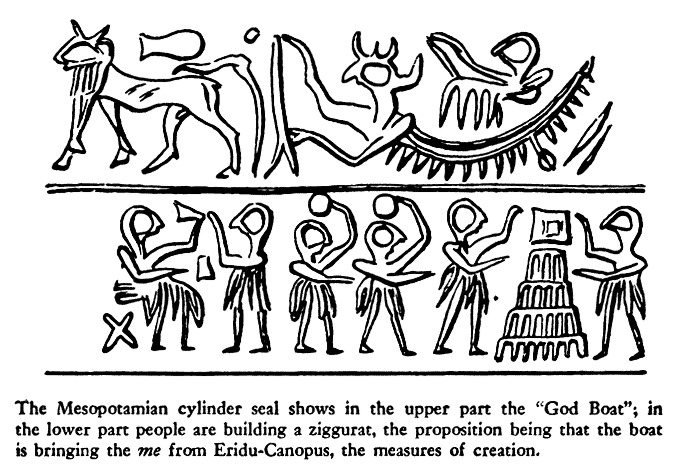
On the left-most side of the plate, the
standing god wears what seems to be a pigtail or a tight-fitting knitted
cap with a tassel. He is much larger than the rest thus dominating the
whole scene. He holds a small man upside down over a bucket-shaped
object; he seems to be either plunging the man in the bucket or pulling
him out. Before the god, under the bucket, a dog is depicted in midair
as if leaping up. The rest of the scene is filled with two rows of
warriors vertically arranged along with the dividing stem of a tree in
between: the upper warriors are horse-riders and the lower warriors are
foot-warriors holding spears and shields. The last three men in the
lower row are blowing musical instruments which are safely identified as
the Celtic instrument, carnyx. Over the carnyx in the far right corner
is depicted a ram-headed serpent similar to that on
plate
(A).
Along with the plate (A), plate (E) is said
to be the most Celtic in its iconography because of the presence of the
carnyx. It consists of a long thin tube at the top of which is added
a boar’s head with jaws wide open and a projecting mane on the back. The
decorated helmets of the warriors in the upper row are also Celtic.
Here, we have five different types of helmets: one has a boar on top,
one a pair of crooked thin horns ending in knobs, one a crescent shape
with concave side down, one a bird with its wings folded. These helmets
with various adornment fit with Poseidonius’s description. Besides,
Olmsted notes that the weapons of the soldiers such as shields with
circular bosses are those of western and central Europe.
However, there are some details which are
not apparently Celtic. For example, the distinctive costumes of the men,
of the same type as those elsewhere on the bowl, are not characteristic
of Celtic Gaul, as Müller observed long ago. Most notably, the round
disc securing the straps on the horse is exactly the same type as an
iron phalera from southern Europe. Both discs consist of a round
central decoration surrounded by smaller circles at the circumference.
Based on this observation, Bergquist argues that it points to the
eastern origin of the cauldron: he quotes from Allen(1971: 24) that the
auxiliary horsemen of the Romans, many of whom came from Thrace rode on
horses "plentifully decked with phalerae" and that such cavalry are
possible agents of the transmission of the phalerae across Europe. Also,
the similar arrangement of figures and plant pattern is found in the
Thracian
helmet from Agighiol on which the horse riders are depicted in
parallel below the horizontal line of ivy pattern. (Bergquist and
Taylor:14)
Concerning the symbolic content of the
scene, quite a few interpretations have been made. The most widely
accepted one is that the scene portrays a ritual dipping and that the
bucket-shaped object is a cauldron of rebirth. This cauldron of rebirth
is associated with Celtic gods, particularly the Dagda in later Irish
literature. Since the scene depicts the warriors and the idea of the
dead being reborn into an after life is common to Celtic mythology, the
theme of rebirth seems quite convincing. In favor of this
interpretation, Ellis Davidson reads the dog and the horned serpent as
symbols of the Other world. On the other hand, Gricourt (1954) suggests
that the scene depicts the dead warriors marching in as spear men below
and riding away alive as horsemen above. However, there seems to be no
guarantee for his interpretation. Olmsted challenges this usual
interpretation by asking why the resurrected warriors rise in rank,
marching up as dead foot soldiers to ride off as horsemen after
resurrection. Furthermore Olmsted argues that the bucket shaped object
is not a cauldron and that the scene depicts a death by drowning which
is often found in Irish tales such as Aided Muirchertaig maic Erca and
Aided Diarmada. Another quite interesting interpretation is made by
Kimmig (1965). He suggests that the foot soldiers are carrying a tree
which is to be placed as a votive offering into one of the sacred pit
shafts which have been excavated on Celtic territory.

(Agighiol helmet)
The Outer plates show 4
male and 3 female busts.
Outer Plate a
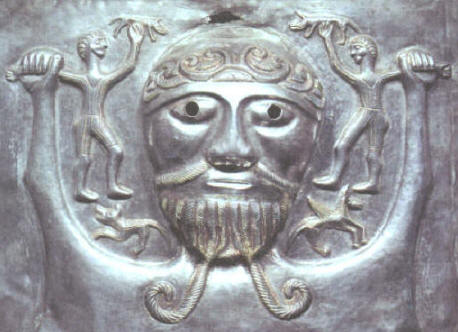
Though many scholars since Müller believe that
there are at least two artists involved in the manufacture of the
cauldron, the outer plates share some basic characteristics. Most of
all, as Sandars points out, all the gods are represented in a static
posture and the scenes show almost symmetrical arrangements of the
figures. Other common features of the gods include the stylized or
patternized hair with the top of the head left bald, no ears, small
mouths, T-shaped line of eye brows and nose, and the insetting of eyes
with glass.
The basic iconographic concept of the outer
plates - arrangement of human busts around the cauldron - has been often
compared with that of
Rynkeby
cauldron and
Bavai
calendar vase from Belgium though the letter is assumed to post-date
the cauldron; it is assumed to be of the early Roman period. Recently,
Bergquist and Taylor suggest that the arrangement of the human bust may
indicate southeastern origin because faces are arranged around bowls in
Southeast Europe too. They also notes that human busts are often
observed in the later Thracian style metal works.
On plate (a), a bearded god holds a small
man in each hand over his shoulders. He is in so-called "orans
position"with his arms raised. Like another male god on
plate
(d), he doesn’t wear a torque; instead he has long whisker-like
strings. Each of the two men seems to hold a boar with one of their
arms. However, from a closer view, one can recognize that each one
reaches his hand upward to a boar and just touches it. The one on the
right has a dog below him while below that on the left is a horse with
wings, a so called "Pegasus." As shown in the inner plates, the
identifications of the scenes on outer plates have not been very
successful either. Olmsted, who reads the whole scene on the cauldron as
a manifestation of the Irish tale, Táin, identifies the central
god with Gaulish equivalent of Cú Rói who judges between the heroes in
the Irish myth. Here, according to his interpretation, the Gualish Cú
Rói judges the champions competing for the boar.
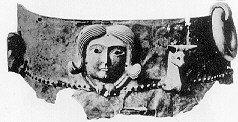 
(Rynkeby Cauldron) (Bavai Vase)
Outer Plate b
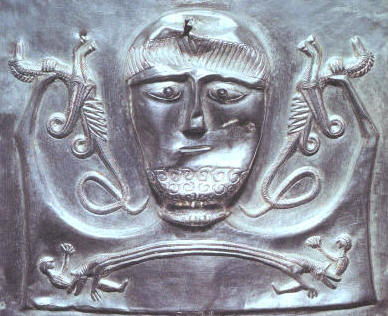
Plate (b) shows a male deity holding two
sea horses or dragons. These two animals have the mixed characters of
horse and dragon; they have a long, serpentine body of a dragon and a
horse-like head and two front legs. Their ribs are prominently fluted
and the tails and wings are swirled. Below the god is a double-headed
monster attacking small figures of fallen men. This double headed
creature has been given a special interest by many scholars. Jacobsthal
associates it with the Early La Tène beast from Cuperly and a two headed
beast on a coin from the Jersey hoard. This monstrous figure, which
continued to appear until late in the Middle Ages, is also said to be an
animated fire-dog, representing the metal frame set frontally across the
fire on an open hearth, with bull or ram heads at either end.(Davidson:
498) A number of such fire-dogs have been recovered from rich Celtic
graves in England and on the Continent. Based on this interpretation,
Ellis Davidson assumes that the men reclining beside it are feasting
beside the hearth and that this iconography may indicate a possible link
between this deity and the Other World in the feast of which the dead
join their ancestors. On the other hand, as early as 1913, Hubert
suggested that this scene should be related to the sea or water since
the god holds the sea horses. As for the central god, he drew parallel
to the Welsh and Irish god of the sea and the other world: Manawydan and
Manannan. As an extension of Hubert's interpretation, Olmsted relates
the god to the Irish character Froech who fights with water monster in
Táin Bó Fraích.
Outer Plate c
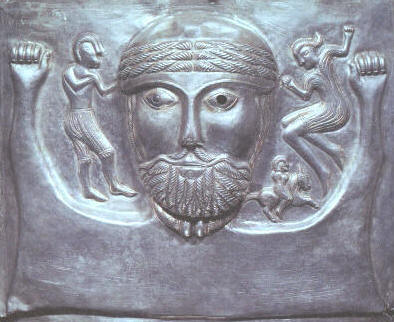
This plates shows a deity with his upraised
hands in "orans position" as the other male gods on the outer plates.
However, unlike the others, his hands are empty. He has a boxing man at
his right and on the left is a leaping figure with a small horse rider
below it. The leaping figure is similar to the one on the
base
with his upturned queue of hair, which is also found in
plate
(g). The two men are dressed in the same type of garment as that
shown on the inner plates, a close fitting jacket or vest with tight
trousers ending at the knee. Since this kind of dress is commonly
observed in horse-riding races, there are no iconographic details
characteristically Celtic or Thracian on this plate. Hence, the depicted
scene has found no parallel either in Celtic mythologies or Thracian
image repertory.
Outer Plate d
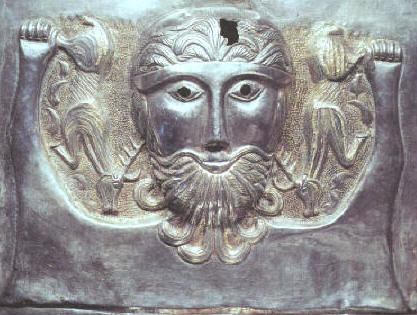
The iconographic details of this plate are
comparatively clear: a bearded god is holding two stags in each hand.
Stylistically, this plate share some characteristics with the
plates
(e) and
(g):
all of them have a dotted background which ends in a zig-zag boundary at
the top of the plate and ivy tendrils which fill the empty spaces
between the figures. Since boars and stags were the major animals
revered by the Celts, one may argue for the Gaulish character of this
plate. But they were sacred animals also among the many other peoples of
central and southern Europe. Olmsted identifies the animals as deer and
the god as Gaulish equivalent of Irish Segamain, who is prominently
associated with deer. However, he admits that deer hunting is a common
feature in the saga literature.
Outer Plate e
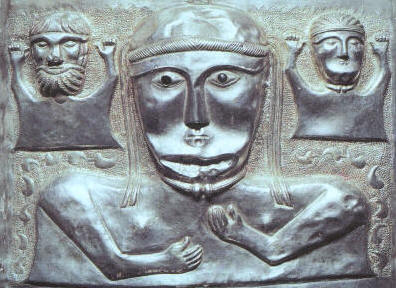
Plate (e) shows a bust of a goddess in the
center and the smaller busts of two male gods on her shoulders. She
wears a torque and has a typical mask-like face with her small mouth and
T-shaped eye brows and nose. The bearded deity on her right shoulder is
almost identical with the central god on the inner
plate
(C) even in their round shaped pattern beneath their beard. They may
represent the same god in a different context or just two different
gods. If the former is the case, this means that the decoration program
of the cauldron is based on a certain kind of narrative or a group of
narratives and that each plate is interconnected with one another
iconographically. In favor of this view, Olmsted identifies the central
goddess with Irish Medb and the two gods with her husband Ail and her
lover Fergus. The tale says that because of her many sexual partners,
she "never had one man without another waiting in his shadow." Based on
this passage, Olmsted suggests that this scene may represent sexual
relationships of Medb. The background of the figures is dotted and
filled with ivy-tendrils as shown on the (d), (g).
Outer Plate f

Plate (f) shows an interesting iconography.
The central goddess holds a small bird in her upraised right hand while
her left arm is placed across her chest. Crossed over her left arm is
lying a small man and on the opposite side to the man is a dog upside
down. Some have suggested that the goddess is cradling the two figures
on her chest. But this would hardly be the case because the figures are
depicted as fallen rather than cradled.(Davison: 498) The goddess has
two birds of prey - which may be eagles or ravens - on either side of
her head. On her right shoulder is seated a small female figure, over
whose head is a lion-like animal runs. On the left side, another small
figure is holding the hair of the goddess as if plaiting her hair.
Olmsted notes that the small bird in her right hand is same as that on
the helmet on
plate
(E): both are seen from the side with a head like those of the
larger birds but with a straight beak and their almond shaped wings are
folded. Though the narrative of this scene is not known, Bergquist and
Taylor associate its iconography with
silver
phalera of Galiche; both show a female bust with a bird above each
shoulder. Since the two plates are of distinctively different style,
their claim does not seem plausible. However, they argue that both are,
nonetheless, in the same technical tradition - high repoussé silver
smithing- and in the same structure of iconography.
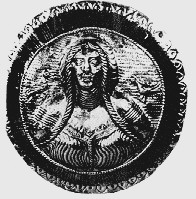 (Galiche phalera)
(Galiche phalera)
Outer Plate g
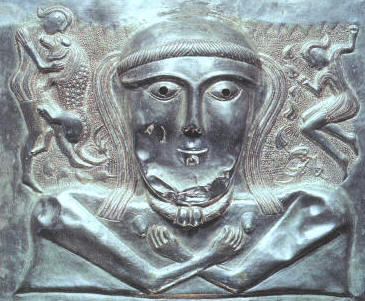
The goddess is crossing her arms on the
chest. On her right shoulder is a man struggling with a lion and on the
left is a leaping figure who is almost identical with the one on
plate
(c) and base plate. The man on the right is often associated with a
motif borrowed from the theme of Heracles and the Nemean Lion. However,
it is a widespread motif of ancient times which can be traced back
beyond classical art to Near Eastern and oriental prototypes. Bergquist
and Taylor compare this plate with that of a silver
jug
from Orlovo in south Russia. In the latter, a female face is flanked
by figures of men: the man on her right is wrestling with an animal and
the other on the left is standing alone. They also have flower blooms
around their bodies as shown on this plate. On the other hand, Olmsted
associates the head of the goddess with that on the
Marborough Vat found in Britain; he notes that the technique of
rendering the eye, nose, eye ridges, and hair is similar.
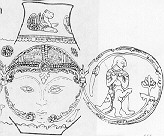 
(Orlovo Jug) (Marborough Vat)
    
(A)
(B) (C)
(D)
(E)
      
(aa)
(bb)
(cc)
(dd)
(ee)
(ff)
(gg)
The proponents of the Gaulish origin put
emphasis on the Celtic motifs depicted on the cauldron such as a
horned
deity,
torques and musical instruments called
carnyx.
Most representative of all, Klindt-Jensen (1959) sees a horned deity as
Cernnunos, the Celtic god and argues that it points toward northern Gaul
as the area of its origin. However, even among those scholars who opt for
the Gaulish origin, iconographic interpretations largely vary with one
another. Instead of reading the horned figure as Cernunnos, Olmsted (1979)
suggests that it is related with the Gaulish Mercury and its Irish counter
part Cu-Chulainn. Actually Olmsted reads the whole iconography of
Gundestrup Cauldron as an illustration of a prototype Tain Bó Cuailnge,
the Irish tale. Though his interpretation is no more secure than those of
the others, Olmsted makes a notable case for the coherent narrative of the
cauldron.
Those who argue for the Gaulish origin
usually locate the cauldron in the final stage of late La tène period,
because by this time, such non Celtic elements as fantastic animals began
to appear in the diverse representations on the Celtic coinage. They also
draw analogy with other bronze cauldrons of Late La Tène period from
central and western Europe. The
Rynkeby
Cauldron which also comes from a Danish bog is the closest example to
the Gundestrup Cauldron: they are almost of the same size; both have
decorative plaques forming the interior of the upper cylindrical wall;
they share some motifs such as a human bust on the outer plates. Since the
Rynkeby Cauldron is assumed to be made around 1st century BC,
in northern or central Europe, Olmsted argues that the Gundestrup
Cauldron, like the Rynkeby Cauldron, has a La Tène III origin.
On the other hand, proponents of the eastern
view base their arguments on the cauldron’s silver smithing techniques and
its portrayal of
fantastic
animals which are commonly observed in Thracian metal work.
Powell(1971) claims the Thracian heritage by demonstrating a strong
stylistic analogy between the Gundestrup Cauldron and
Thracian
phalerae. The techniques of decorating bodies of animals with hatching
lines and punched dots are common in both. Most recently, Bergquist and
Taylor further developed his argument. By locating the cauldron in late 2nd
century BC, they claimed that silver-smithing techniques used for the
cauldron such as high repoussé, pattern punches and tracers, partial
gilding, and insetting of glass are as yet unknown from the Celtic West.
Bergquist and Taylor divide the Thracian style into two periods: earlier
style by the fourth century BC when, after Persian invasion, distinctive
and original animal style art had emerged in Thracia, and later style at
the turn of the 2nd and 1st century when the hoards
of silver vessels reappeared after two hundred years of absence. They
consider that the two styles are basically homogeneous except that in the
later style, human figures are emphasized and usually rendered in high
repoussé and they conclude that the Gundestrup Cauldron shows the traits
of both styles.
If the Cauldron was made elsewhere than
Denmark, then how did it make its way north to Jutland ? To explain its
discovery in Denmark, several options are brought up. Klindt Jensen
assumes that the cauldron was a Celtic object imported into Denmark.
Olmsted suggests that it was a war booty because the Romans employed
Germanic cavalry in Gaul. Bergquist and Taylor propose that it was made in
southeast Europe by a Thracian silver smith, possibly commissioned by
Celts (Scordisci) and transported by Cimbri who invaded the Middle lower
Danube in 120 BC and looted the Scordisci. They make conjecture that since
the cauldron takes the 4th century BC Thracian style and lacks
the Roman tradition, it was made between fourth and first century BC.
Bibliography
-
Arbman,
H., "Gundestrupkitteln- ett galliskt arbete?," Tor 20, 1948,
pp.109-116.
-
Bémont,
C., "Le Bassin de Gundestrup: remarques sur les décors végétaux,
Etudes Celtiques, vol. 16, Paris, 1979, pp. 69-99.
-
Benner
Larsen, E., "The Gundestrup Cauldron, Identification of Tool Traces,"
Iskos, vol. 5, 1985, pp. 561-74.
-
Berciu,
D., Arta traco-getica, Editura Aacademiei, Bucharest, 1969.
-
Bergquist,
A. K., and T. F. Taylor, "Thrace and Gundestrup Reconsidered,"
Proceedings of the Seventh International Congress of Celtic Studies,
Oxford: D. Ellis Evans, 1983, pp.268-9.
-
------------------------------, "The origin of the Gundestrup
Cauldron," Antiquity, vol. 61, 1987, pp. 10-24.
-
Bober,
J.J., "Cernunnos: Origin and Transformation of a Celtic Divinity,"
American Journal of Archeaology 55, 1951, pp13-51.
-
Davidson,
H. E., The Lost Belief of Northern Europe, 1993.
-
-------------------, "Mithraism and the Gundestrup bowl," Mithraic
Studies Vol. II (edited by John R. Hinnells), Rowman and Littlefield,
Manchester, 1975.
-
Drexel,
F., "Über den Silberkessel von Gundestrup," Jahrbuch des Kaiserlich
Deutschen Archäologischen Instituts 30, 1915, pp.1-36.
-
Grosse,
R., Der Silberkessel von Gundestrup, ein Ratsel keltische Kunst,
Goetheanum, Dornach, 1963.
Hawkes, C. F. C., " Continental and British Anthropoid Weapons",
Proceedings of the Prehistoric Society, XXI, 1955, pp. 198-227.
-
Hawkes,
C.F.C., and M.A. Smith, "On Some Buckets and Cauldrons of the Bronze
and Early Iron Ages," Antiquity XXXVII, 1957, pp.131-98.
-
Jacobsthal, P., Early Celtic Art, Oxford, 1944.
-
Kimmig,
W., "Zur Interpretation der Opferszene auf den Gundestrup-Kessel,"
Fundberichte aus Schwaben, N.S. xvii, 1965, pp.135-43.
-
Klindt-Jensen, O., "The Gundestrup Bowl-a reassessment," Antiquity,
vol.33, pp.161-9.
-
---------------------, Gundestrupkedelen, Copenhagen, 1979
-
Laet, S.
J. and P. Lambrechts, "Traces du culte de Mithra sur le chaudron de
Gundestrup," Actes du troisième Congrès International des sociétés
pré- et protohistoriques, Zurich: City-Druck, 1950, pp. 304-6.
-
Megaw, J.
V. S., Art of the European Iron Age, Adams & Dart, Bath, 1970.
-
Meyers,
p., "Three silver objects from Thrace: a technical examination,"
Metropolitan Museum Journal 16, 1981, pp.49-54.
-
Müller,
Sophus, "Det store Slvkar fra Gundestrup i Jylland," Nordiske
Frotidsminder, I, 1892, pp.35-68.
-
-------------------, Nordische Altertumskunde, vol. 2, Strasburg,
1898.
-
Nylen, E.,
"Gundestrupkitlen och den thrakiska konsten," Tor 12, Uppsala, 1967,
pp. 133-73.
-
Olmsted,
G.S., "The Gundestrup version of Táin Bó Cuailnge," Antiquity, vol.50,
pp.95-103.
-
-----------------, The Gundestrup Cauldron, Collection Latomus, No.
162, Brussels, 1979.
-
Petersen,
E., "A Gundestrup edény és a Csórai dombormu," Archeologiai Ertesito
13, pp.199-202.
-
Piggott,
S., "The Carnyx in Early Iron Age Britain," The Antiquaries Journal
XXXIX, 1959, pp.19-32.
-
-------------, "Supplementary notes on the illustrations," The Celts
(T.G.E. Powell, 2nd ed), London: Thames & Hudson, 1980,
pp.210-217.
-
Pittioni,
R., Wer hat wann und wo den Silberkessel von Gundestrup angefertigt?
Veröffentilichungen der keltischen
-
Akademie
der Wissenschaften 3. Vienna: Verlag der Österreichischen Asademia der
Wissenschaften, 1984.
-
Powell,
T.G.E., "From Urartu to Gundestrup: the agency of Thracian
metal-work," The European Community in Later
Prehistory, Routledge & Kegan Paul, London, 1971.
-
Ramskou,
T., "Gundestrupterrinen," Skalk 4, 1977, p.32.
-
Reinach,
S., "À propos du vase de Gundestrup," L’Anthropologie 5, 1894,
pp.456-8.
-
--------------, "Zagreus, le serpent cornu," Revue Archéologique,
XXXV, 1899, pp.210-217.
-
--------------, "Les Carnassiers androphages dans l’art gallo-romain,"
Revue Celtique 25, 1904, pp.207-24.
-
Reinecke,
P., "Autremont und Gundestrup," Praehistorische Zeitschrift 34-5 (1),
1950, pp.361-72.
-
Rusu, M.,
"Das Keltische Fürstengrab von Ciumesti in Rumänien, Bericht der
Römisch-germanischen Kommission 50, 1969, pp.267-300.
-
Sandars,
N. K., Prehistoric Art in Europe, Bartimore, 1968.
-
------------------, "Orient and Orientalizing in Early Celtic Art,"
Antiquity XLV( no.178, 1971), pp.103-112.
-
------------------, "Orient and Orientalizing: recent thoughts
reviewed," Celtic Art in Ancient Europe (C.F.C. Hawkes and
P.M. Duval ed.), London, 1976, pp.41-57.
-
Willemoes,
A., Hvad nyt om Gundestrupkarret, Nationalmuseets Arbejdsmark,
Copenhagen, 1978.
http://en.wikipedia.org/wiki/Gundestrup_cauldron#Interpretation
Timothy Taylor theorises that Thracian
silverworkers were an itinerant class (who he compares to present-day
Romani people) who were valued for magical and ritual services as well
as for their metalworking (itself an important ritual occupation), and
who, though living in southeastern Europe, would not have considered
themselves Thracian. He suggests they may have been a feminised caste of
men fulfilling functions of priesthood and seership, like the
Enarees of Scythia and similar groups attested across Eurasia in the
Iron Age. The figure on the cauldron typically identified with Cernunnos
is unbearded, in contrast with all the other male figures, and the similar
Mohenjo-Daro figure, though having male genitalia, is dressed in female
clothes, his posture resembling a yogic posture for channeling sexual
energy still used by a caste of Indian sorcerers.[5]
Taylor speculates that the "Cernunnos" figure, of ambiguous gender, may
have been a deity of particular importance to the Thracian silverworking
caste, part of a magical tradition common across Eurasia and still
surviving in tantric yoga and Siberian shamanism.[2]
Link:
Gundestrup cauldron

A photo of the Gundestrup cauldron

Detail of the antlered figure
depicted on plate A of the cauldron
The Gundestrup cauldron is a
richly-decorated
silver vessel, thought to date to the
1st century BC, placing it into the late
La Tène period.[1]
It was found in 1891 in a
peat bog near the hamlet of Gundestrup, in the
Aars
parish in
Himmerland,
Denmark ( 56°49′N
9°33′E
/ 56.817°N
9.55°E /
56.817; 9.55). It is now housed at
the
National Museum of Denmark in
Copenhagen. 56°49′N
9°33′E
/ 56.817°N
9.55°E /
56.817; 9.55). It is now housed at
the
National Museum of Denmark in
Copenhagen.
The Gundestrup cauldron is the
largest known example of
European Iron Age silver work (diameter 69 cm, height 42 cm).
The style and workmanship suggest
Thracian origin, while the imagery seems
Celtic. This has opened room for conflicting theories of
Thracian vs.
Gaulish
origin of the cauldron. Taylor (1991) has suggested Thracian
origin with influence by
Indian iconography.
Discovery
The cauldron was discovered by peat
cutters in a small peat-bog called Rævemose, at Gundestrup, on May
28, 1891. The Danish government paid a large reward to the
finders, who subsequently quarreled bitterly amongst themselves
over its division.[2][2][3]
The cauldron was found in a dismantled state, with five long
rectangular plates, seven short ones, one round plate (normally
termed the 'base plate') and two fragments of tubing stacked
inside the curved base. Palaeobotanical investigation of the
surrounding peat showed that the land had been dry when the
cauldron was deposited, and the peat had since gradually grown
over it. The manner of stacking suggests an attempt to make the
cauldron inconspicuous and well-hidden.[3]
Construction
The original ordering of the outer
and inner rectangular plates is uncertain, although in two places
a sharp object has apparently pierced through both an outer and an
inner plate, which can thus be aligned with some certainty. The
plates retain traces of solder, but since they seem to have been
separated by 2 cm strips of metal (now missing), rather than
soldered directly together, these traces do not help in matching
adjacent plates. One of the eight original outer plates is
missing. The circular 'base plate' originated as a
phalera, or horse's bridle decoration, and it is commonly
thought to have resided in the bottom of the bowl as a late
addition, soldered in to repair a hole.[2]
By an alternative theory, this phalera was not initially part of
the bowl, but instead formed part of the decorations of a wooden
cover.[3]
The cauldron has been repaired, and possibly even dismantled and
reassembled, multiple times, and the repair quality is inferior to
the original craftmanship.[2]
The silversmithing of the plates is
very skilled. The bowl, 70 cm across, was beaten from a single
ingot. For the relief work on the plates, the sheet-silver was
annealed to allow shapes to be beaten into high repoussé;
these rough shapes were then filled with pitch from the back to
make them firm enough for further detailing with punches and
tracers. The pitch was then melted out. Areas of pattern were
gilded, and the eyes of the larger figures were probably inset
with glass. The plates were probably worked in the flat and then
bent into curves to solder them together.[3]
Using
scanning electron microscopy Benner Larson has identified 15
different punches used on the plates, falling into three distinct
groups. No individual plate has marks from more than one of these
groups, and this fits with previous attempts at stylistic
attribution, which identify at least three different silversmiths.[3]
The plates show wear and buckling,
mostly consistent with having been forcibly torn apart at the
seams. Some of the wear may, however, hint at an even earlier
arrangement of the plates and subsequent reconstruction.[3]
Origins
For many years scholars have
interpreted the cauldron's images in terms of the Celtic pantheon.
The antlered figure in plate A has been commonly identified as
Cernunnos, and the figure holding the broken wheel in plate C
is more tentatively thought to be
Taranis. There is no consensus regarding other figures. The
elephants depicted on plate B have been explained by some
Celticists as a reference to
Hannibal's crossing of the
Alps.[2]
The silverworking techniques used in
the cauldron are unknown from the Celtic world, but are consistent
with the renowned
Thracian sheet-silver tradition; the scenes depicted are not
distinctively Thracian, but certain elements of composition,
decorative motifs and illustrated items (such as the shoelaces on
the "Cernunnos" figure) identify it as Thracian work.[3]
The silver in the cauldron cannot be
tracked to an individual mine by lead isotope analysis, since the
melted coins such artifacts are normally made of can originate in
many mines. The variety of coin used has, however, been determined
with some certainty, by careful analysis of weights: a total
weight of 9445 grams was reconstructed for the entire cauldron,
and 4255 grams for the bowl alone, and these were found to be
nearly precise integer multiples of the weight of the Persian siglos, a coin weighing 5.67 grams. By this calculation 1,666
coins were used in total, 750 of them in the bowl. This supports
an origin in Thrace, where Persian weights were in common use. The
phalera base plate, added to the cauldron at a later date, also
originated in Thrace.[2]
Depictions
Base Plate
The circular base plate depicts a
bull, above its back a female figure wielding a sword, and two
dogs, one over the bull's head, and another under its hooves.
Exterior Plates
Each of the seven exterior plates
centrally depicts a bust, probably of a deity. Plates a, b, c, and
d show bearded male figures, while the remaining three are female.
- On plate a, the bearded
figure holds in each hand a much smaller figure by the arm. Each
of those two reach upward toward a small boar. Under the feet of
the figures (on the shoulders of the god) are a dog on the left
side and a winged horse on the right side.
- The god on plate b holds in
each hand a sea-horse or dragon. In Celtic-origin theories, the
image has been associated with the Irish sea-god
Manannan.
- On plate c, a male figure
raises his empty fists. On his right shoulder is a man in a
"boxing" position, and on his left shoulder a leaping figure
with a small horseman underneath.
- Plate d shows a bearded
figure holding a stag by the hind quarters in each hand.
- The female figure on plate
e
is flanked by two smaller male busts.
- On plate f: the female
figure holds a bird in her upraised right hand. Her left arm is
horizontal, supporting a man and a dog lying on its back. She is
flanked by two birds of prey on either side of her head. Her
hair is being plaited by a small woman on the right.
- On plate g, the female
figure has her arms crossed. On her right shoulder, a scene of a
man fighting a lion is shown. On her left shoulder is a leaping
figure similar to the one on plate c.
Interior plates
Plate A:
Antlered Figure
Plate A centrally shows a horned male
figure in a seated position. In its right hand, the figure is
holding a
torc, and with its left hand, it grips a horned serpent by the
head. To the left is a stag with antlers very similar to the
humanoid. Other animals surround the scene, canine, feline,
bovine, elephant, and a human figure riding a fish or a dolphin.
The scene has been compared to a similar seal found in the
Indus Valley. In theories of Celtic origin, the figure is
often identified as
Cernunnos and occasionally as
Mercury.
In his 1928 book "Buddhism in
pre-Christian Britain" Donald Mackenzie proposed the figure was
related to depictions of the Buddha, and of the Western Buddha-god
Virupaksha.[4]
Detail of interior plate A
|
|
Plate B:
Female figure with Wheels
Plate B shows the bust of a female,
flanked by two six-spoked wheels and by mythical animals: two
elephant-like creatures and two griffins. Under the bust is a
large hound.
Plate C:
Broken Wheel

Plate C: the broken
wheel
Plate C shows the bust of a bearded
figure holding on to a broken wheel. A smaller leaping figure with
a
horned helmet also is holding the rim of the wheel. Under the
leaping figure is a horned serpent. The group is surrounded by
griffins and other creatures, some similar to those on plate
B. The wheel's
spokes
are rendered asymmetrical, but judging from the lower half, the
wheel may have had twelve spokes, which has been compared with
with
chariot burials excavated in
East Yorkshire.[citation
needed] In theories of Celtic origin the figure has
been associated with the Irish
Dagda.
Plate D:
Bull Hunting
Plate D shows a scene of
bull-slaying. Three bulls are depicted in a row, facing right.
Each bull is attacked by a man with a sword. Under the hooves of
each bull is a dog running to the right, and over the back of each
bull is a cat, also running to the right.
Plate E:
Warriors and Cauldron

Plate E: initiation ritual
In the lower half, a line of
warriors bearing spears and shields, accompanied by
carnyx players march to the left. On the left side, a large
figure is immersing a man in a cauldron. In the upper half, facing
away from the cauldron are warriors on horseback. This has been
interpreted[who?]
as an initiation scene.
Interpretation
The Gundestrup cauldron is the
largest known example of European
Iron Age silver work.
Despite the absence of any known
tradition of sheet silver
repoussé in Celtic Gaul or north-western Europe, the
decorations on the walls of the cauldron have been widely
identified with
Celtic deities and rituals. The appearance of torques around
the necks of some of the figures on the cauldron also suggest a
connection with Celtic culture. Because of these, and because of
the size of the vessel (diameter 69 cm, height 42 cm), it is said
to have been used for initiatory or sacrificial[citation
needed] purposes in
Celtic polytheism.
Bergquist and Taylor propose
manufacture by a Thracian craftsman, possibly commissioned by the
Celtic
Scordisci and fallen into the hands of the
Cimbri who invaded the Middle lower
Danube in 120 BC. Olmsted interprets the iconography as a
prototype of the
Irish myth of the
Táin Bó Cuailnge, associating the horned figure with
Cú Chulainn rather than with Cernunnos.
Timothy Taylor theorises that
Thracian silverworkers were an itinerant class (who he compares to
present-day
Romani people) who were valued for magical and ritual services
as well as for their metalworking (itself an important ritual
occupation), and who, though living in southeastern Europe, would
not have considered themselves Thracian. He suggests they may have
been a feminised caste of men fulfilling functions of priesthood
and seership, like the
Enarees of Scythia and similar groups attested across Eurasia
in the Iron Age. The figure on the cauldron typically identified
with Cernunnos is unbearded, in contrast with all the other male
figures, and the similar Mohenjo-Daro figure, though having male
genitalia, is dressed in female clothes, his posture resembling a
yogic posture for channeling sexual energy still used by a caste
of Indian sorcerers.[5]
Taylor speculates that the "Cernunnos" figure, of ambiguous gender,
may have been a deity of particular importance to the Thracian
silverworking caste, part of a magical tradition common across
Eurasia and still surviving in tantric yoga and Siberian shamanism.[2]
References
-
^ Encylopedia Britannica
[1]
-
^
a
b
c
d
e
f
g Taylor, Timothy (1992) "The
Gundestrup Cauldron" in Scientific American March 1992,
pp. 66-71.
-
^
a
b
c
d
e
f
g Bergquist, A. K. & Taylor, T.
F. (1987) "The origin of the Gundestrup cauldron" in
Antiquity Vol. 61, 1987. pp. 10-24.
-
^ "Buddhism in pre-Christian Britain", Donald A.
Mackenzie, p45
-
^ This was first pointed out by Thomas McEvilley of
Rice University, in "An Archaeology of Yoga" in Res
Vol. 1, Spring 1981, pp. 44-77.
- Kaul, F., and J. Martens,
Southeast European Influences in the Early Iron Age of Southern
Scandinavia. Gundestrup and the Cimbri,
Acta Archaeologica, vol. 66 1995, pp. 111-161.
- Klindt-Jensen, O.,
The
Gundestrup Bowl — a reassessment, Antiquity, vol. 33, pp.
161-9.
- Olmsted, G.S., The Gundestrup
version of
Táin Bó Cuailnge, Antiquity, vol. 50, pp. 95-103.
- Cunliffe, Barry (ed.),
The
Oxford Illustrated Prehistory of Europe, NY: Oxford
University Press, 1994, 400-402.
- Green, Miranda J.,
Dictionary
of Celtic Myth and Legend. (NY: Thames and Hudson, 1992,
108-100.
See also
|

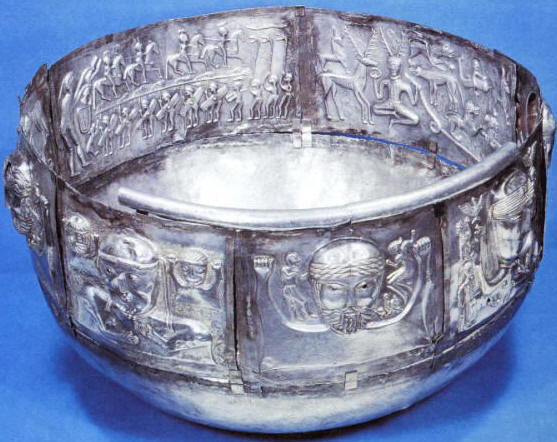




 (Phalera from
Stara Zagora)
(Phalera from
Stara Zagora) 
 (Agighiol Vase)
(Agighiol Vase) 











 (Galiche phalera)
(Galiche phalera) 



















